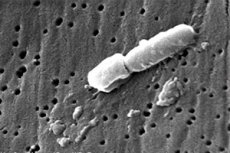Medical expert of the article
New publications
Klebsiella in the feces of an adult and a child
Last reviewed: 07.07.2025

All iLive content is medically reviewed or fact checked to ensure as much factual accuracy as possible.
We have strict sourcing guidelines and only link to reputable media sites, academic research institutions and, whenever possible, medically peer reviewed studies. Note that the numbers in parentheses ([1], [2], etc.) are clickable links to these studies.
If you feel that any of our content is inaccurate, out-of-date, or otherwise questionable, please select it and press Ctrl + Enter.

Klebsiella is a type of enterobacteria that is a conditionally pathogenic microorganism. These are capsule-shaped gram-negative rods, located singly, in pairs or chains. They are considered very dangerous, because they are resistant to existing antibiotics. They are found on the skin, respiratory tract, water, soil, vegetables and fruits, feces. The shell helps them survive in any nutrient medium, they can exist without air, and only boiling destroys them.
Klebsiella norm in stool analysis
Klebsiella is detected during a stool test for dysbacteriosis. Its presence is not a sign of pathology if it does not exceed the norm - 10 5 cells per gram.
In order for the bacteria to become active, factors conducive to this are necessary: weakened immunity, long-term use of antibiotics, ignoring hygiene rules (unwashed hands, food), diabetes, alcoholism and drug addiction. [ 1 ]
Klebsiella pneumonia in stool
There are 7 varieties of Klebsiella, one of which is Klebsiella pneumoniae. It was originally discovered as a causative agent of pneumonia, hence its name. It was later found that its reproduction leads to the release of toxins, the damage to which causes other diseases, including urogenital cystitis, abscesses of the spleen, liver, pleurisy and a number of other diseases. The bacillus is found in feces. [ 2 ]
Klebsiella oxytoca in stool
Another type of bacteria found in feces is Klebsiella oxytoca. It causes digestive disorders, pneumonia, and Klebsiella. [ 3 ]
Klebsiella in feces in adults
Klebsiella is transmitted by the feco-oral and contact-household routes. The weakened organism of an adult who ignores the rule of clean hands and sufficient heat treatment of products is attacked by opportunistic bacteria, causing acute symptoms. Stool analysis reveals an increase in bacilli in geometric progression.
If one person in a family becomes ill, there is a high probability that others will become infected as well.
Klebsiella in child's stool
Children are especially susceptible to the disease, as they often come into contact with animals and do not understand the importance of hygiene. Klebsiella can peacefully coexist inside them for a while, but only when the right moment for their activation comes, the disease will manifest itself.
Cases of infection of infants with Klebsiella are common. The immunity of newborns is weak, not fully formed, the mucous membranes of the internal organs are sterile, therefore they are highly susceptible to the harmful effects of the bacillus toxins. Oxytokes are usually found in their feces.
You can get infected from adults by airborne droplets, while the carriers themselves do not suffer, their defenses cope with the bacteria. Other ways to catch the pathology are dirty pacifiers, nipples, toys, as well as when feeding - fermented milk products, meat can contain it.
Symptoms
Symptoms of Klebsiella infection depend on the location of the lesion. If the gastrointestinal tract is affected, then symptoms of acute poisoning will appear:
- abdominal pain;
- nausea and vomiting,
- high body temperature;
- diarrhea;
- body aches;
- lack of appetite.
Pneumonia caused by Klebsiella causes a sharp jump in temperature above 39ºС, a strong cough, sometimes with fragments of blood in the sputum. It is also possible to develop rhinitis, sinusitis, conjunctivitis with the symptoms characteristic of these diseases: runny nose, lacrimation, stinging and pain in the eyes, nasal congestion.
The genitourinary system is often affected: cystitis and pyelonephritis are diagnosed, accompanied by frequent urge to go to the toilet, painful urination, cloudy urine, pain in the lower abdomen, often radiating to the back, and high temperature.
In women and girls, Klebsiella can cause vaginitis, which is characterized by copious vaginal discharge of white or gray color with an unpleasant odor and itching.
Involvement of the skeletal system in the pathological process, including provocation of joint inflammation, is no exception.
Treatment
In case of Klebsiella infection, antibiotics sensitive to the pathogen are prescribed. These may be gentamicin, amikacin, cephalosporins: cefotaxime, cefuroxime. The bacillus is also destroyed with the help of viral agents - bacteriophages: Klebsiella pneumoniae, oxycyta, polyvalent.
In parallel, enzymes are used: pancreatin, linex, festal; rehydration solutions. In severe cases, immunostimulants are appropriate. The course of treatment can last from a week to three. Probiotics, vitamin preparations, and herbal infusions are used for rehabilitation.
Proper and timely treatment gives a favorable prognosis for recovery, but the progression of the proliferation of bacilli causes dangerous consequences, including death.

